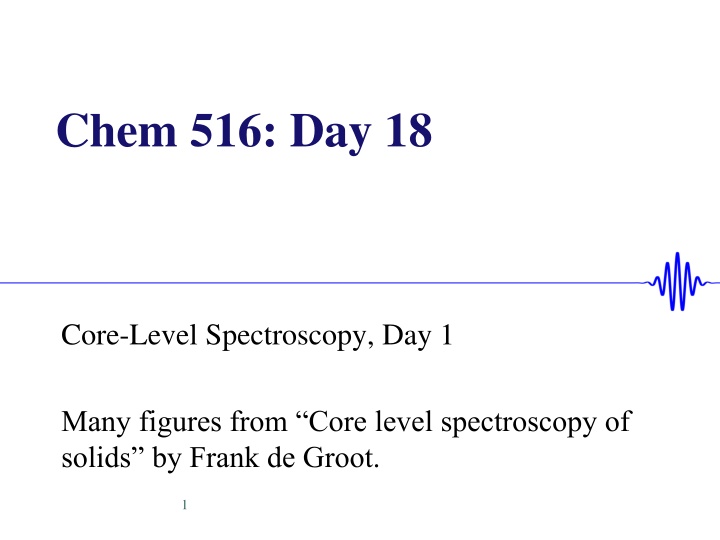
Core-Level Spectroscopy of Solids: Energy Ranges and Measurements
Explore the energy ranges and spectroscopic measurements in core-level spectroscopy of solids, covering topics such as X-ray Absorption Spectroscopy (XAS) and Photoelectron Spectroscopy (XPS). Learn how XPS measures the energy of occupied orbitals and its implications for oxidation state determination. Discover element-specific transition energies and notations for different energy levels.
Download Presentation

Please find below an Image/Link to download the presentation.
The content on the website is provided AS IS for your information and personal use only. It may not be sold, licensed, or shared on other websites without obtaining consent from the author. If you encounter any issues during the download, it is possible that the publisher has removed the file from their server.
You are allowed to download the files provided on this website for personal or commercial use, subject to the condition that they are used lawfully. All files are the property of their respective owners.
The content on the website is provided AS IS for your information and personal use only. It may not be sold, licensed, or shared on other websites without obtaining consent from the author.
E N D
Presentation Transcript
Chem 516: Day 18 Core-Level Spectroscopy, Day 1 Many figures from Core level spectroscopy of solids by Frank de Groot. 1
Lets look at the energy ranges weve seen so far cm-1 nm eV 10-7 1010 10-3 NMR: molecular structure EPR: metal spin/structure 10-5 108 10-1 10-3 106 101 Infrared: vibrations 10-1 104 103 LUMO, L+1, 100 UV/Vis/NIR: Frontier orbital elec. structure 103 104 HOMO, H-1, 101 102 105 102 101 106 Metal 2p XANES/EXAFS: electronic structure, active site geometry 103 100 107 Metal 1s 104 Mossbauer: spin/ox state 2
X-ray absorption spectrum of MnO 10 1 Absorbance 0.1 0.01 0.001 100 1000 10000 Energy (eV) These transition energies are element-specific: Fe 1s is ~7100 eV, Ni 1s is ~8330 eV 3
Some notation for the different levels M2,3edge M1edge K edge (for Oxygen) L3edge Spin-orbit split L2edge L1edge K edge 4
There are two general things measured with core-level spectroscopy Photoelectron spectroscopy (XPS) X-ray Absorption Spectroscopy (XAS) 5
XPS measures the energy of occupied orbitals Photoelectron spectroscopy (XPS) In the experiment, you use a fixed photon energy and measure the photoelectron energy: = ?.?.+?? ??????????? 1) Set this 2) Measure this 3) Calculate the Binding Energy as your answer Quick groups: If I shoot photons with energy of 10,000 eV at a FeCo alloy, and electrons fly out with kinetic energies of 2888 eV and 2291 eV, what are the 1s energies of Fe and Co? Which is which? Fe: 7112 eV, Co: 7709 eV 6
What does this tell you? XPS is a good measure of oxidation state (or electron density in general) When valence electrons are removed from an atom (either formal ox state change or inductively from e-- withdrawing ligands), the other electrons are held more tightly. In general, an oxidation state change of +1 leads to an increase in binding energy of ~1-2 eV. 7
Example: XPS of perovskite solar cells I 3d, L=2. remove an electron, get 1 hole, S=1/2 So J=5/2, 3/2 Note the axis looks backward that is the convention Groups: How do you expect the Pb 4f peaks to shift when going from CH3NH3PbI3 to CH3NH3PbBr3? 8 J. Phys. Chem. C, 2015, 119 (4), pp 1818 1825)
Lets zoom in Pb 4f electrons are bound ~0.5 eV More tightly in CH3NH3PbBr3 DFT calculations predict a charge on Pb of +0.13 in -PbI3 and +0.65 in -PbBr3 9
Group activity For each of the spectroscopies we have discussed in class (UV/Vis, IR, Raman, EPR, Mossbauer, XPS), draw a diagram showing the initial and final (and any intermediate) states. Hold these up to your camera to show your group, and be ready to show to the class 10
Final projects Choose a paper from your own group that uses one or more of the spectroscopies we ve learned about in class We have learned just the basics of each technique, but there are many more details that we didn t have time to cover Your job is to dive deeply into the paper and figure out exactly how they analyzed the spectrum: Why does the EPR spectrum actually look like that: why is superhyperfine only on g ? How do they actually fit the g-values (EasySpin, some other program?) The IR spectrum indicates that the CO ligand is weakly bound : Oh really? Why exactly? How did they quantify this? How did they model the EXAFS spectrum? Can you reproduce it in their software? You should have to learn new aspects of the technique beyond what we covered in class, and clearly explain those new concepts Write this up in an 8-10 page paper (single spaced). The primary audience is future members of your current group: imagine the document you d like to have right now to understand your group s techniques. Secondary audience is the people in this class: start from what they know now If there is some software they used to fit/model/calculate the spectrum, you should reproduce their spectra and play with the parameters 11
